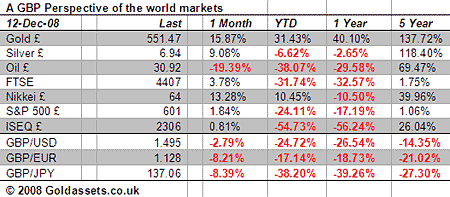
With the economic slowdown and the consequent fall in jewellery sales, jewellers have recently begun touting the merits of jewellery and diamonds as being ‘investments’. This is dangerous nonsense that may lose investors even more of their hard earned savings. Here’s why
First, jewellery and diamonds attract VAT at very high levels. On the other hand, investment grade gold bullion (0.9999 or 24 carat), coins, bars or government gold certificates are stamp duty and VAT free due to the EU Gold Directive.
Second, gold bullion coins, bars and certificates can be put in a pension fund, unlike diamonds and jewellery – another reason that they are not ‘investments’.
Another important consideration is that the jewellery market is known for having huge mark ups over the actual gold content or intrinsic precious metal value of the jewellery itself. A very large necklace that contains one ounce of pure gold (0.9999 pure or 24 carat) will normally cost well in excess of 250% of the market price for gold. For example, if the price of gold is £550/oz, the necklace may cost well over £1,375. A gold bar which also contains one ounce of pure gold will cost £550, plus a much smaller mark up of some 5% – or £577.50.
This is just when you buy. Selling is just as important to consider. When the owner of a piece of jewellery goes to sell their ‘investment’ they will be lucky to get 30% of its cost price back. In fact, most jewellers will not even consider buying the piece back. The buyer will be forced to sell it at a massively discounted price in a pawnshop or on Ebay.
This huge instant depreciation is not seen in the market for gold itself. A gold certificate or gold bars can be bought at 2% to 6% over the live market gold price. A day, week, month, year or years later, the same gold certificate or gold bars will automatically be bought back by a bullion broker or government mint at near 100% of the market value – at some 1% below the actual market price, or even slightly above the market price.
The spread between the buy and the sell price for investment-grade gold bullion is in the low single digits – tiny. Whereas the spread between the buy and sell price for rare stones or jewellery is extremely high, making any sort of investment return nigh-on impossible.
There is no local or international marketplace where jewellery or rare stones are traded on an exchange as there is with equities, commodities, bonds, currencies and gold. And so there is no efficient market or price-discovery mechanism. All this means that the price of jewellery and rare stones is subjective, and subject to the whims of individual jewellers and valuers.
But unlike jewellery and rare stones, investment grade gold bullion (0.9999 pure) has an inverse correlation to property and equity markets, as was seen in the 1930’s and 1970’s – and in recent months.
Jewellery and rare stones are not investments. Some quality jewellery pieces and top quality, very rare stones may be stores of value and may retain their value in the event of a continuing and deep recession. However, the vast majority of jewellery pieces and rare stones will fall in value.
In the current unprecedented financial and economic climate there are very few safe havens, but gold bullion remains one. Central bank gold sales and the leasing of gold have artificially suppressed the price in recent years, but with gold lease rates surging and central banks concerned about financial, economic and systemic contagion, this source of supply is set to dwindle in the coming months. Indeed, many central banks are adding to their gold reserves.
The German Bundesbank recently said they view gold as an essential monetary asset. “National gold reserves have a confidence and stability-building function for the single currency in a monetary union.” The wise sages in the Bundesbank believe that financial and political uncertainty make their gold reserves even more important than before. The Bundesbank is the world’s second-largest holder of gold after the US Federal Reserve. In in the past five years, it has sold just 20 tonnes out of total reserves of over 3,000.
As ever, real diversification is absolutely essential to all investors. Best-of-breed equities, property, commodities, government bonds, cash and gold bullion should be included in all investors’ portfolios in order to protect ourselves in 2009.
And so this Christmas, by all means buy jewellery or a diamond as a beautiful gift for a loved one. But do not buy it as an ‘investment ‘ that will protect you from the global economic recession. It won’t.
•This article was written by Mark O’Byrne, executive director of Gold and Silver Investments Ltd.